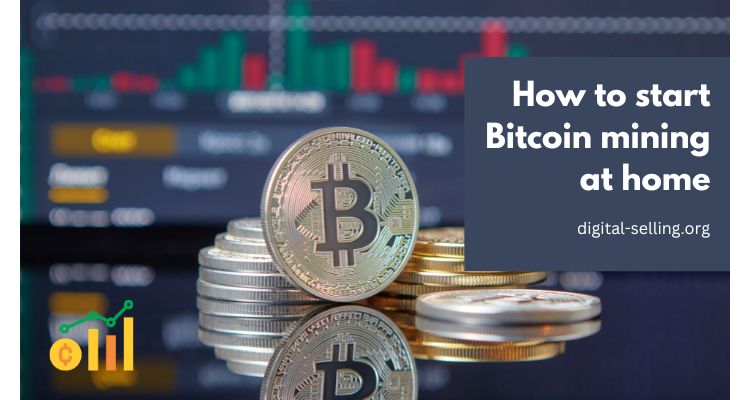Understanding how to start Bitcoin mining at home is a utopia moment for many of us who have been try to earn some crypto for years.
Bitcoin mining is a complex and resource-intensive process, and mining using a computer browser is not a practical or efficient way to mine Bitcoin. However, I can provide you with an overview of how Bitcoin mining works and how you can get started if you’re interested in mining cryptocurrency.
1. Understand Bitcoin Mining
Bitcoin is a decentralized digital currency that relies on a technology called blockchain. Also, Bitcoin transactions are grouped into blocks, and miners compete to solve complex mathematical puzzles to validate and add these blocks to the blockchain. In return, as you create new Bitcoins and transactions you gain a commission.
2. Equipment Requirements
Traditional Bitcoin mining requires specialized hardware called ASIC (Application-Specific Integrated Circuit) miners. These machines are designed for the sole purpose of mining and are much more efficient than regular computers. Mining with a computer browser is impractical due to low processing power and energy efficiency.
3. Choose Your Mining Method
To get started with Bitcoin mining, you must choose between two primary methods:
- Cloud Mining: In this method, you rent mining hardware from a cloud mining provider and pay a fee for their services. This is an easier option for beginners, as it doesn’t require you to set up or maintain hardware, but it can be less profitable.
- Mining Pools: Most small-scale miners join mining pools, where participants combine their computational power to increase their chances of successfully mining Bitcoin. Rewards are then distributed among pool members based on their contributions.
4. Select a Wallet
You’ll need a Bitcoin wallet to receive and store the Bitcoins you mine. Wallets come in various forms, including software wallets, hardware wallets, and paper wallets. So, ensure you choose a secure option and back up your wallet’s private keys.
5. Join a Mining Pool
If you opt for mining in a pool, choose a reputable mining pool that aligns with your goals and preferences. Some well-known mining pools include Slush Pool, F2Pool, and Antpool. Sign up, create a worker, and configure your mining software accordingly.
6. Download Mining Software
For mining, you’ll need mining software that’s compatible with your hardware. Popular mining software options include CGMiner, CT Farm, and EasyMiner. In addition, these programs connect your computer to the mining pool and manage the mining process.
7. Configure Your Mining Setup
Configure the mining software with your pool’s details and your wallet address. So, depending on your hardware and software, you might need to adjust settings for optimal performance.
8. Start Mining
Once everything is set up, you can start mining. Keep in mind that Bitcoin mining requires a significant amount of computational power as well as can strain your computer’s hardware, leading to increased electricity consumption and wear and tear.
9. Monitor Your Progress
Regularly check your mining pool’s website to monitor your progress, earnings, and the status of your mining hardware. You can also use third-party tools to track your mining activities.
10. Understand Costs and Profitability
It’s important to be aware of the costs associated with Bitcoin mining, including electricity expenses and potential maintenance costs. So, remember to use an online calculator to estimate your potential profitability based on your hardware’s hash rate and your electricity costs.
11. Security and Backup
Implement security measures to protect your mining setup and stored Bitcoins. In addition, regularly back up your wallet and enable two-factor authentication wherever possible.
12. Stay Informed
The world of cryptocurrency is constantly evolving. So, stay informed about changes in the Bitcoin network, mining hardware, and software updates that may affect your mining operation.
13. Legal and Tax Considerations
Make sure to comply with local laws and regulations related to cryptocurrency mining and report any income for tax purposes.
14. Sustainability and Environmental Impact
Be mindful of the environmental impact of Bitcoin mining. So, as the process consumes a significant amount of electricity, consider using energy-efficient hardware and renewable energy sources if possible.
Final words about how to start Bitcoin mining at home
In summary, while it’s not practical to mine Bitcoin with a computer browser it is possible for the complete beginner. Alternatively, you can start in Bitcoin mining by acquiring specialized mining hardware, joining a mining pool, and following best practices for security and sustainability. Keep in mind that the cryptocurrency mining landscape is highly competitive. Also, profitability can fluctuate based on Bitcoin’s price and the efficiency of your mining setup. Therefore, it’s essential to do thorough research and carefully consider your investment in terms of both time and money.





7 thoughts on “How to start Bitcoin mining at home”